Once known as the ninth planet in our Solar System, Pluto derived its name from the Roman god of the underworld. However, in 2006, astronomers reclassified Pluto, sparking curiosity about its actual status in our cosmic neighborhood.
The Discovery Story
Back in 1930, American astronomer Clyde William Tombaugh made a groundbreaking find at the Arizona Observatory, named after Percival Lowell. Unraveling the mystery of Pluto proved to be a challenging endeavor. Tombaugh meticulously compared photographic plates capturing the celestial expanse, taken two weeks apart over the course of almost a year. Only by tracking the shifting positions of objects like planets, comets, and asteroids could he pinpoint Pluto’s presence.
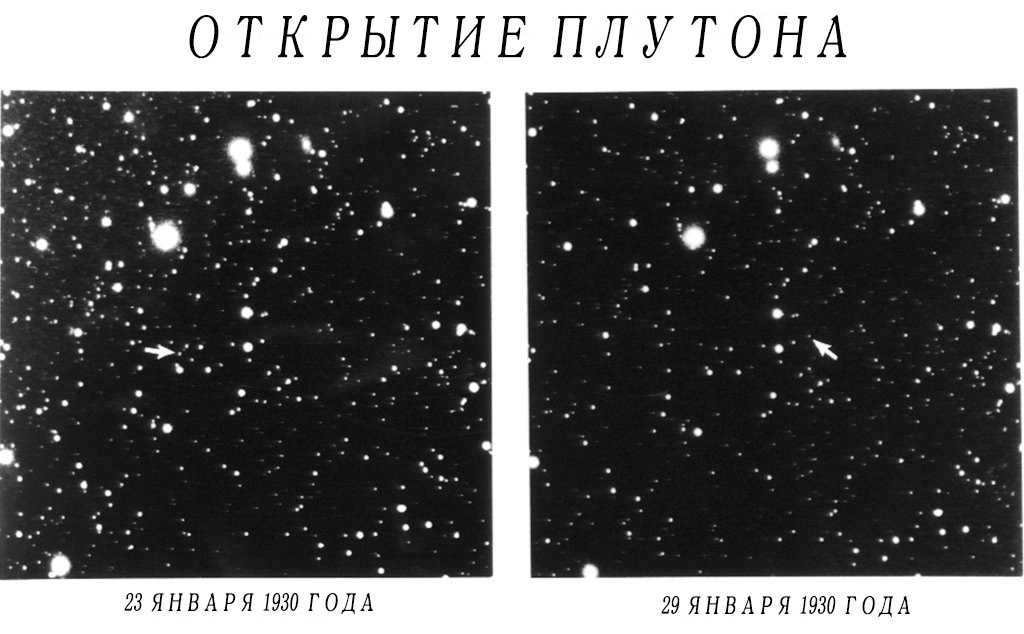
The exploration of Pluto was a challenging task due to its relatively modest dimensions and mass in the vastness of the universe, as well as its inability to cleanse its orbit from comparable celestial bodies. However, despite devoting nearly an entire year to this investigation, the scientist successfully identified the ninth planet within our solar system.
Only a little person
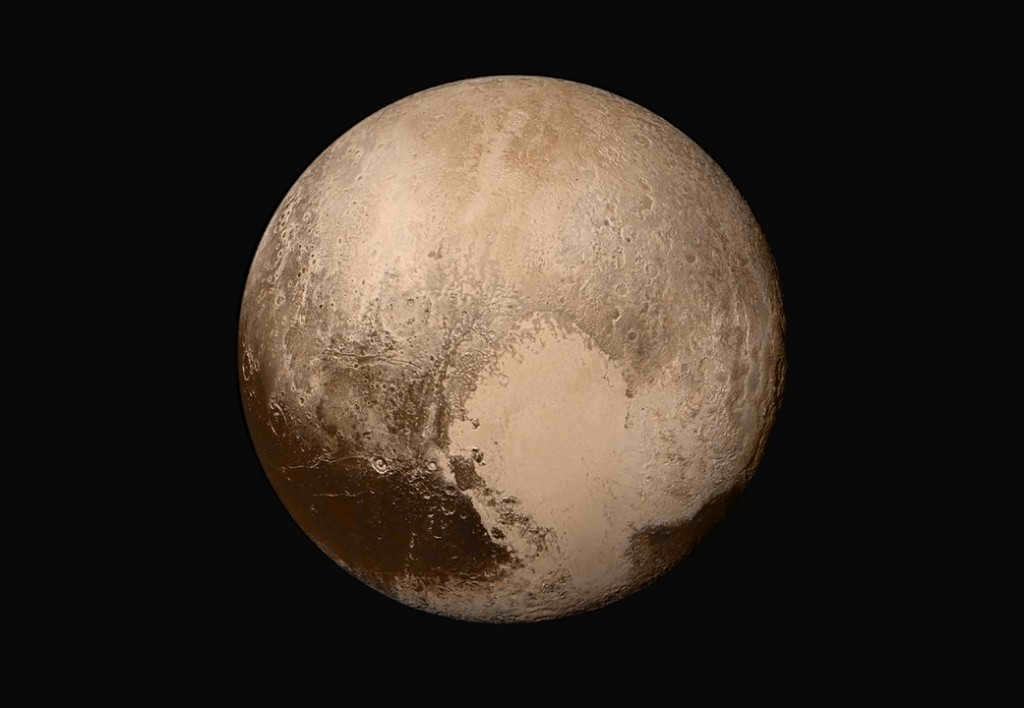
A color image of Pluto taken by the New Horizons probe is displayed above.
For a long time, scientists struggled to accurately determine the size and mass of Pluto. However, in 1978, the discovery of the satellite Charon provided the necessary information. It was found that Pluto has a mass of only 0.0021 times that of Earth and a radius of 1200 km. While this may seem small in comparison to other celestial bodies, at the time, scientists believed that Pluto was the furthest planet in the system and that there was nothing beyond it.
Throughout the past few decades, advancements in ground-based and space-based technological devices have significantly altered humanity’s perspective on the universe and assisted in clarifying the question: why isn’t Pluto considered a planet? Recent data reveals that there are approximately 70,000 objects resembling Pluto, both in size and composition, within the Kuiper belt. It wasn’t until 2005 that scientists, led by Mike Brown and his team, finally recognized that Pluto is merely a diminutive “dwarf” planet. This realization came about when they discovered a celestial body just beyond Pluto’s orbit, which they later named Erida (2003 UB313). Erida boasts a radius of 1300 km and a mass that is 25% larger than that of Pluto.

The 26th General Assembly of the International Astronomical Union, which took place in Prague from August 14 to 25, 2006, made the final decision regarding the fate of Pluto, stripping it of its “Planet” title. The organization established four criteria that all planets in the Solar System must satisfy:
- The object must orbit the Sun.
- The object must have sufficient mass to form a spherical shape through its gravity.
- The object must not be classified as a moon or satellite of another planet.
- The object must clear its orbit of other small objects.
Pluto met all of these requirements except the last one, leading to its reclassification as a dwarf planet along with similar celestial bodies.
Briefly about Pluto
Pluto, which was discovered in 1930 and was once considered a full-fledged planet of the solar system until 2006, had its status downgraded to that of a dwarf planet due to the discovery of other celestial bodies comparable to Pluto in mass and size. Despite being classified as a dwarf planet, Pluto still remains an intriguing world in its own right.
Regardless of how people classify Pluto, it continues to occupy its place in the solar system and remains a fascinating and relatively unexplored celestial body.
Interesting information about Pluto
There are a number of intriguing facts related to this celestial body:
- The name of the planet was coined by Venetia Burney, an 11-year-old girl from Oxford. She determined that the name of the god of the underworld was fitting for a planet so distant from the Sun. The name was a perfect match, especially since the initials P and L also represent Percival Lowell’s initials.
- Since its discovery in 1930, Pluto has only completed one-third of its orbit. It has experienced only one change in season.
- Pluto, although now classified as a dwarf planet, is the largest in its category among all known planets. The closest planet, Erida, is slightly smaller with a diameter of 2326 kilometers compared to Pluto’s 2372 kilometers.
- Pluto is composed of approximately one-third water ice. Its surface is predominantly covered in ice, and when considering all the oceans on Earth, Pluto has three times as much water as our planet.
- In comparison to the large moons of other planets, Pluto is relatively small. It is approximately half the size of the Moon and over five times lighter. It is smaller than Ganymede, Titan, Io, Callisto, Europa, and Triton.
- Unlike the other planets, Pluto’s orbit is highly elongated and does not align with their plane.
- Pluto has only been visited by one spacecraft, the New Horizons probe, which conducted a flyby in 2015.
- Pluto possesses an atmosphere that undergoes periodic fluctuations. At times, the atmosphere becomes less dense, while at other times, it becomes denser. This is due to the melting and condensing of methane ice as Pluto moves closer to and farther away from the Sun.
- Pluto possesses a sizable partner, Charon, with a mutual center of gravity positioned beyond them, resulting in both of them orbiting around that center. As a result, Pluto is classified as a binary planet – a novel category, as no other similar entity has been discovered yet.
- Traditionally, recently discovered chemical elements are designated with names derived from newly found planets. For instance, the element plutonium, which was discovered in 1941, was named after Pluto.
- Pluto boasts a vast expanse known as the Companion Plain, which is filled with nitrogen ice, and within it, ice floes and icebergs composed of water ice drift.
- The icy mountains on Pluto can reach heights of up to 5 kilometers due to the extremely frigid temperatures and the formidable strength of the ice.
Discovery of Pluto: A Historical Account
The fascinating tale of the discovery of the distant planet Pluto dates back to the 1840s, a time when Uranus reigned as the most recently confirmed celestial body. However, inconsistencies between its calculated and actual motion prompted scientists to speculate the existence of another planet lurking farther out in the cosmos. Eventually, thanks to the groundbreaking calculations made by a brilliant French mathematician, Neptune was unveiled, providing a partial explanation. Yet, intriguingly, discrepancies persisted, leading to the suspicion that an elusive ninth planet was at play, exerting its influence on its neighboring celestial bodies.
In 1906, Percival Lowell, the visionary founder of the esteemed Lowell Observatory, proposed the search for the enigmatic “planet X.” With great anticipation, this quest for discovery commenced. However, despite their earnest efforts, the astronomers were unable to locate this elusive planet during Lowell’s lifetime. Sadly, Percival Lowell passed away in 1916, leaving the mystery of “planet X” unsolved.
Afterwards, the Lowell Observatory found itself embroiled in a decade-long legal dispute with Lowell’s widow – she sought a million-dollar sum from the observatory, claiming it was part of her inheritance. Consequently, the search for planets took a backseat during this time.
However, in 1929, the hunt resumed and the task was assigned to 23-year-old American Clyde Tombaugh, who had recently joined the ranks of the Lowell Observatory.


Clyde Tombaugh, the American astronomer who made the discovery of Pluto.
Tombaugh approached the task with great enthusiasm and dedicated a year to capturing images of every area of the sky at regular intervals. He then used a blink comparator, a device that enables the observer to detect movement by rapidly switching between photos.
By creating this type of animation with a few frames, he was able to make the significant find. On February 18, 1930, Tombaugh discovered the planet, and on March 13, it was officially announced at the Harvard Observatory.
Pluto’s orbit
Pluto’s orbit differs from the orbits of the other planets in the solar system. It possesses a significant eccentricity of 0.2488, which means it has an elliptical shape. Additionally, the Sun is not positioned precisely at the center of this orbit but is slightly displaced. As a result, the distance between Pluto and the Sun varies greatly throughout its orbit, ranging from 4.4 billion km to 7.4 billion km, or 29.7 a.u. to 49.3 a.u. One complete revolution around the Sun takes Pluto 247.92 Earth years, constituting one local year.
The point in Pluto’s orbit that is closest to the Sun is known as perihelion, which is nearly twice as close as the farthest point, aphelion. Surprisingly, Pluto is even closer to the Sun at perihelion than Neptune. Although it may seem like the orbits of these two planets intersect, in reality, they do not.
Unlike the other planets, Pluto’s orbit does not lie in the same plane. It has an inclination of 17.14°, meaning it is tilted compared to the other planetary orbits. When Pluto reaches perihelion and gets close to Neptune’s orbit, it is actually 10 astronomical units (a.u.) further away from it. This is quite a significant distance.
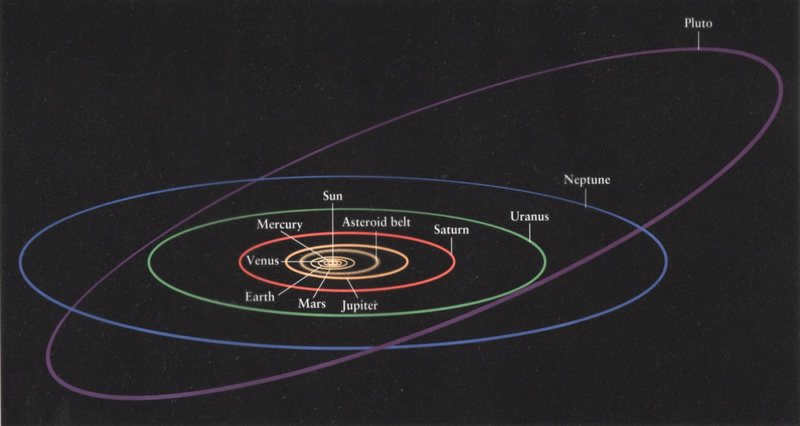

Pluto’s path around the Sun is not aligned with the flat plane of the Earth’s orbit.
The paths of Pluto and Neptune never cross each other and these two planets are in a special relationship called orbital resonance – for every three revolutions Neptune makes around the Sun, Pluto completes two revolutions. As a result, they always come close to each other at the same points in their orbits, and the distance between them is always at least 17 astronomical units. When Neptune and Pluto line up with the Sun, Pluto is at its farthest point from the Sun, known as aphelion. The complete cycle of their alignment, starting from the same position, takes 495 years.
The stable orbits of Pluto and Neptune have remained unchanged for millions of years. It is possible that Pluto’s orbit was different in the past, but over time, due to the gravitational forces exerted by Neptune and other planets, it settled into its current trajectory and is expected to remain this way for a considerable period. However, if Pluto’s orbit coincided with the plane of the other planets’ orbits, Neptune would eventually capture Pluto and turn it into its satellite.
Pluto completes one orbit around its axis in 6.387 days, which is equivalent to 6.387 Earth days. Interestingly, its rotational direction is opposite to that of Venus. Furthermore, Pluto has a significant tilt of 120° on its axis, which is much greater than Earth’s tilt. As a result, the seasons on Pluto are significantly more pronounced. At present, the northern hemisphere of Pluto is experiencing springtime, as its north pole is facing the Sun. This spring season began back in 1987. During a solstice on Pluto, a quarter of its surface remains permanently illuminated and warm, while the remaining three-quarters are in shadow, creating an extended period of darkness.
Pluto’s dimensions and weight
Upon the initial discovery of Pluto, researchers attempted to determine its weight by examining its perceived impact on Uranus and Neptune. Initially, the newly found planet was believed to be six times larger than Earth. However, as time progressed, this estimation was revised downwards, first matching the size of Earth and then Mars. The prevailing belief was that if Mars, with a diameter of 6700 km, were located at the same distance as Pluto, its luminosity would be equivalent, indicating similar dimensions between the two planets. This understanding persisted until 1950.
Subsequently, the dimensions of Pluto were further refined and gradually decreased. Based on the most recent information gathered by the New Horizons spacecraft, the diameter of Pluto measures 2376 kilometers. The total surface area of this celestial body is smaller than that of the former USSR, though slightly larger than that of Russia alone. In comparison to the Moon, it is approximately 40% smaller in size.
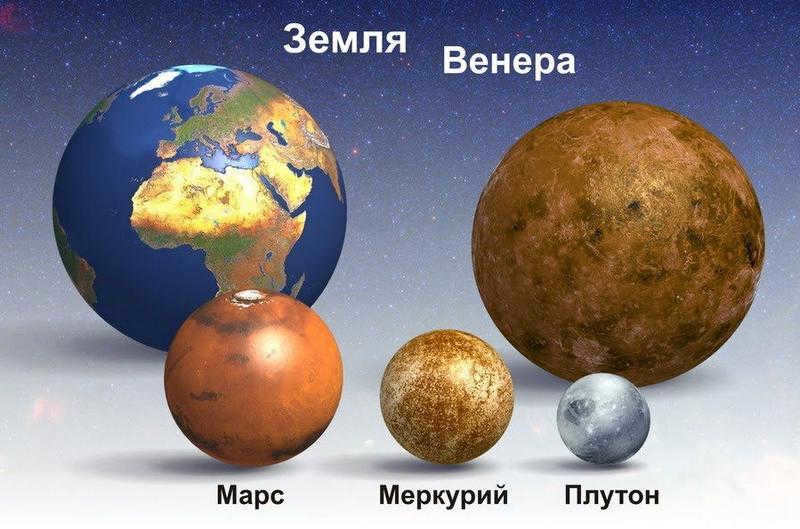
Pluto is not as massive as many of the larger moons of other planets. It weighs only one-sixth of the Moon and 480 times less than the Earth. However, Pluto holds the title of being the largest known dwarf planet. It is 14 times heavier than Ceres and twice its size. Interestingly, it is even slightly bigger than Erida, despite being 25% lighter than it.
Pluto remains relatively unexplored due to its remote location and small size. Even with the powerful Hubble Space Telescope, our observations of Pluto are limited to discerning only irregular patches on its surface. Consequently, our primary source of information about this dwarf planet comes from the New Horizons probe, which conducted a flyby in 2015.
Pluto boasts a highly contrasting surface, surpassing all other celestial bodies in our solar system, with the exception of Saturn’s moon, Iapetus. The albedo, or reflectivity, varies greatly within different regions of Pluto, ranging from 10 to 70%. As a result, as Pluto rotates, its brightness can fluctuate by up to 0.3 magnitudes.
Scientists hypothesize that at the center of Pluto lies a rocky core made of silicate rock. This core is enveloped by a 300 km thick mantle of various types of water ice. If the radioactive decay occurring in the core produces sufficient energy, this mantle could exist in a liquid state, suggesting the possibility of a subglacial ocean in the planet’s history. As this ocean froze and contracted, the surface of Pluto developed distinct features such as graben and ledges that are observed today.
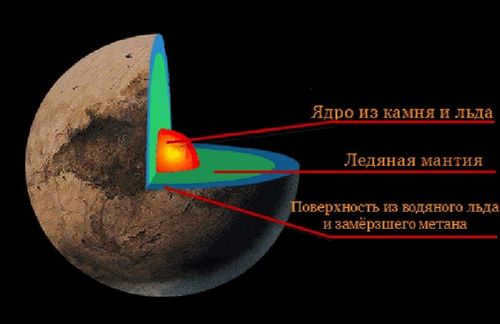

The atmosphere of Pluto is extremely thin. It is composed of gases that freeze and condense on the surface as they move farther away from the Sun, and then vaporize as they get closer. The main gases in Pluto’s atmosphere are nitrogen, methane, and carbon monoxide. Under the influence of solar radiation, these gases combine to form other compounds such as ethane and acetylene. It is believed that these compounds create a haze that extends up to 200 kilometers above the surface of Pluto.
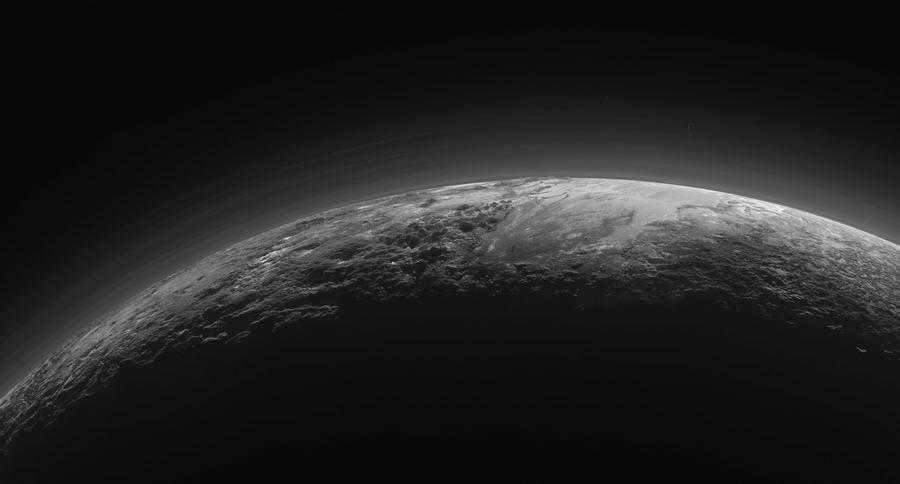

Pluto’s atmosphere is clearly visible in the photographs taken by the New Horizons probe.
Despite its low density, the atmosphere contains methane, which creates a greenhouse effect. While the surface temperature averages around -223 degrees Celsius, it increases by 3-15 degrees per kilometer of altitude. On average, the atmosphere is 40 degrees warmer than the surface. This thin atmosphere effectively smooths out the temperature fluctuations throughout the day and night.
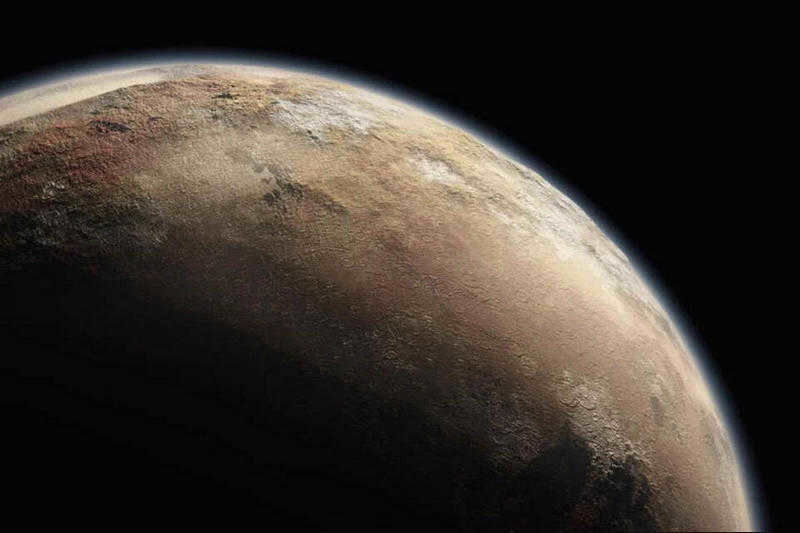

Another image depicting the atmosphere of Pluto.
Pluto’s exterior
Pluto’s outer layer also contains a significant amount of water ice; however, it is concealed beneath a different form of ice – frozen nitrogen, methane, carbon monoxide, and other gases. These substances have the ability to thaw as they approach the Sun, ultimately forming an atmosphere. The average surface temperature on Pluto is -223.15 0 C.
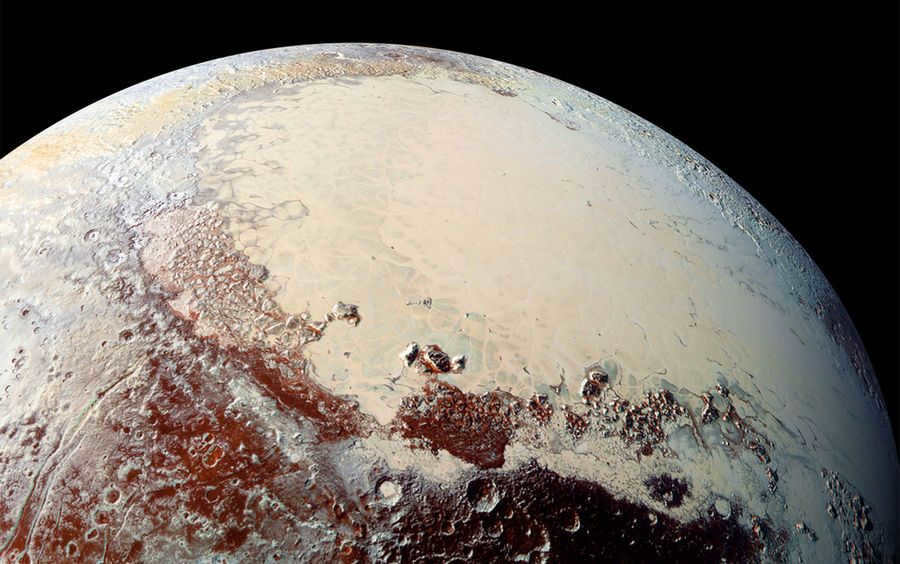
Pluto’s surface. Image captured by the New Horizons spacecraft.
The most notable feature currently observed on Pluto is the Sputnik Valley. This depression spans over 1000 km and covers about 5% of the planet’s total surface. Scientists believe it to be an ancient impact crater that has undergone erosion over time.
The Sputnik Valley is filled with frozen nitrogen ice, while surrounding it are mountains composed of water ice. Due to water ice’s lower density compared to nitrogen ice, fragments of it can float within the valley like icebergs. Convection processes take place in the nitrogen ice, creating furrows where numerous small dark hills can be seen. These hills are likely ice floes made of regular water ice and they are capable of floating throughout the entire valley. However, this floating movement is extremely slow, with the icebergs only displacing a few centimeters per year.
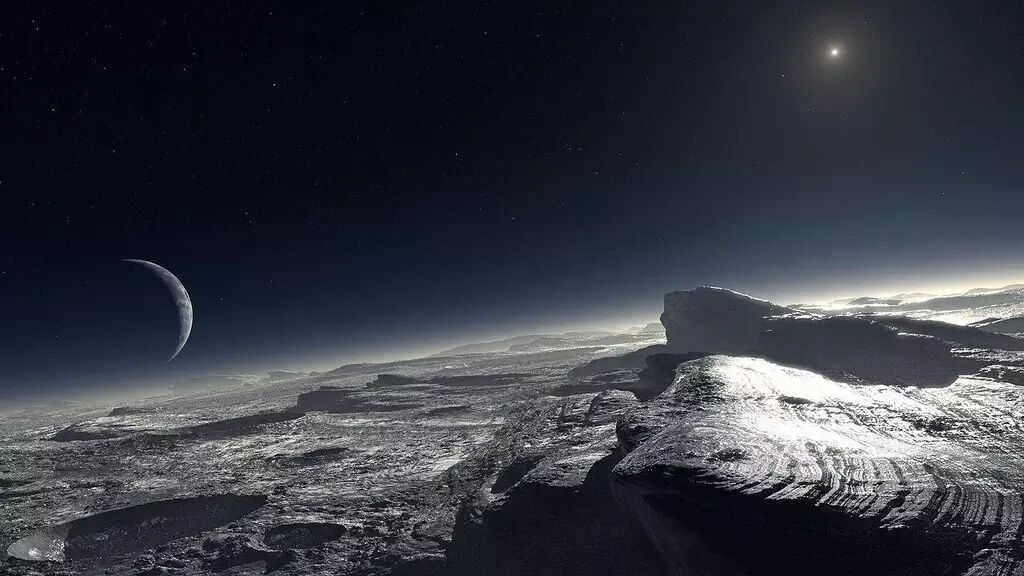

Pluto, the dwarf planet, has some fascinating features. One of them is a vast expanse of nitrogen ice, where icebergs and ice floes can be seen. Interestingly, the water ice on Pluto is incredibly strong due to the extremely low temperatures, resulting in ice mountains that reach heights of up to 5 km.
Another notable feature on Pluto is a massive bright region in the shape of a heart, spanning about 1800×1500 km. This elevated area is adorned with ice mountains that can reach heights of up to 3.5 km.
Moons of Pluto
Pluto currently has a total of 5 confirmed moons. The most prominent and largest moon is Charon, which is approximately half the size of Pluto. Among the other moons, Hydra and Nycta stand out as they are sizable asteroids with irregular shapes, measuring several tens of kilometers in diameter. On the other hand, the moons Kerber and Styx are smaller in size, with a diameter of only a few kilometers.
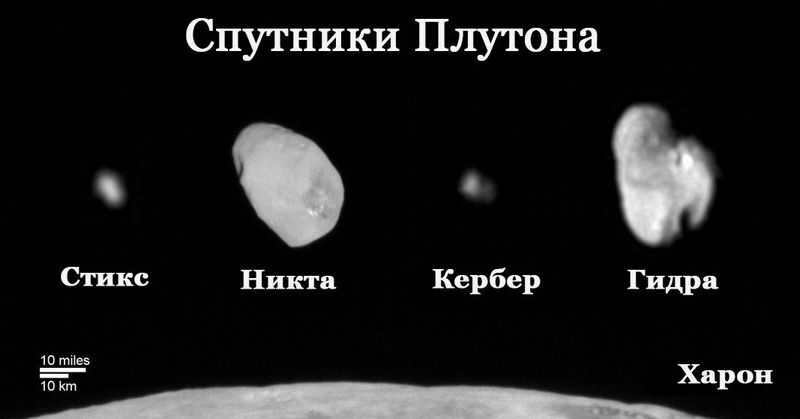
Undoubtedly, the most fascinating moon of Pluto is Charon. Its discovery was documented on July 7, 1978. Charon has a diameter of 1212 kilometers, slightly over half the diameter of Pluto, and its mass is 1/8 of the mass of Pluto. Because their masses are relatively similar, the center of mass they share is located beyond the surface. Consequently, in this system, Charon does not orbit around Pluto, but rather, they both orbit around a common center. Naturally, this common center is much closer to Pluto, resulting in Charon’s revolutions having a smaller radius.
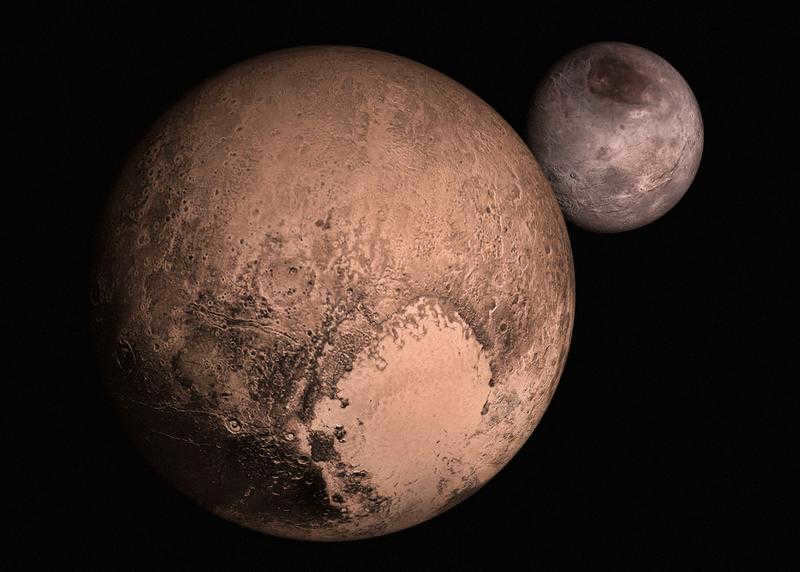
A comparison is being made between the sizes of Pluto and Charon.
Due to the positioning of the center of mass between Pluto and Charon, as well as their shared revolutions around it, some astronomers refer to this system as a double planet. However, there is currently no official classification for this, even though it is a relatively uncommon type of celestial object. When Pluto was reclassified as a dwarf planet, Charon did not receive the same designation, even though it is also a fairly large object. As a satellite of Pluto, it remains classified as such.
The distance between the center of Pluto and Charon can reach up to 19596 km. Similar to the relationship between the Moon and Earth, Charon and Pluto are tidally locked, meaning they always face each other with the same side. This means that Charon is always visible and never sets on one side of Pluto, while on the other side it is never visible.
Charon’s surface is believed to contain a significant amount of water ice. There is also a hypothesis that cryogeysers may exist on the moon.
From 1930 to 2006, Pluto was recognized as a full-fledged member of the solar system. However, starting in 1992, scientists started uncovering new objects in the Kuiper Belt that were quite comparable in size to Pluto. In 2005, they even found Erida, which is just a few kilometers smaller than Pluto and was even referred to as the tenth planet by some.
As more and more similar planets were discovered in the Kuiper Belt, the question of reevaluating Pluto’s status arose. The criteria for being classified as a planet were as follows:
- Orbits around the Sun in its own path.
- Has sufficient mass to form a spherical shape.
- Clears its own orbit of objects other than its own moons.
Due to the fact that Pluto cannot remove many other bodies from its orbit in the Kuiper Belt, some of which are of similar size and mass, it fails to meet the third condition. Consequently, in 2006, the International Astronomical Union demoted Pluto from its planetary status and reclassified it as a dwarf planet. It still remains the largest in its category and leads a group of similar celestial bodies known as “plutoids”. Instead of a name, it was given the designation 134340 in the small planet catalog.
Not all scientists and regular individuals agreed with this reclassification of Pluto’s status. Disagreements and debates arose. Americans, in particular, were outraged since it was the only planet discovered by an American astronomer.
As a result of all this, the concept of “opluto” emerged, which refers to downgrading Pluto.
Research on Pluto
Due to its vast distance and small size, exploring Pluto is an incredibly challenging task. Its brightness in the sky is only around 14m, making it necessary to employ a powerful telescope to even detect it. Unfortunately, telescopic observations from Earth are largely ineffective when it comes to studying the planet’s surface. Even the renowned Hubble Space Telescope can only discern large patches of varying colors on Pluto.
Back in 1977, when Voyager 1 embarked on its journey to explore the planets, it had the potential to approach Pluto. However, the mission’s priority was to pass by Saturn and Titan. It wasn’t until 2006 that the New Horizons mission was launched, with Pluto being one of its primary objectives. On board this spacecraft, the ashes of Clyde Tombaugh, the discoverer of Pluto who passed away in 1997, were also carried.
The New Horizons spacecraft completed a flyby of Pluto on July 14, 2015, when it came within 12,500 kilometers of the dwarf planet. The mission’s scientific investigation actually began five months before the closest approach, as the probe started studying Pluto and its moon Charon from a much greater distance. This groundbreaking mission provided the first-ever detailed images of both Pluto and Charon, as well as a wealth of other important scientific data.
As of now, there are no future planned missions to Pluto.
Astrophysics is now recognized as one of the most divisive and rapidly progressing fields of study. While classical physics and mathematics are governed by well-established principles that have been widely accepted as facts and fundamental truths, astronomers are constantly confronted with new discoveries and evidence that challenge long-held assumptions. Recent advancements in technology have allowed scientists to delve deeper into the mysteries of the cosmos, leading to more frequent situations like the controversy surrounding Pluto in modern scientific research.
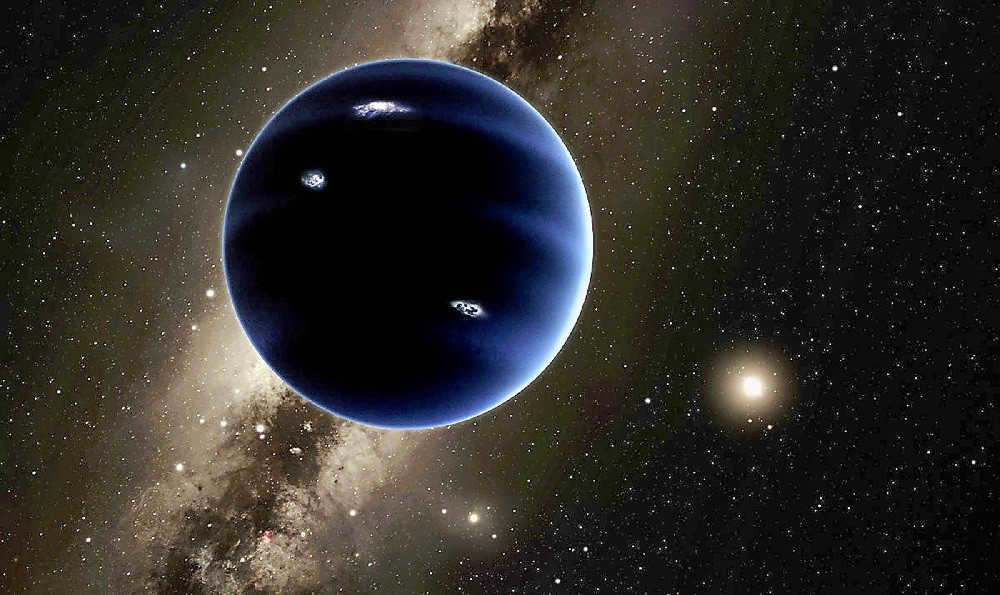
Ever since its discovery in 1930, Pluto has held the status of a full-fledged planet, ranking ninth in the order of celestial bodies in the Solar System. However, this classification did not last long – only 76 years. In 2006, the scientific community made the decision to remove Pluto from the list of planets, reclassifying it as a dwarf planet. This move was a major departure from the traditional understanding of the solar system and set a new precedent in modern science. What led to this radical decision by the scientific community and what implications might it have for future exploration of our cosmic neighborhood?
The primary characteristics of the recently discovered dwarf planet
The decision to reclassify the ninth planet as a dwarf planet was not made hastily. In just 76 years, which is relatively short in the realm of astrophysics, significant advancements have been made in scientific understanding. These advancements have led to doubts regarding the status of Pluto as a planet.
Only a few decades ago, all astronomy textbooks and planetariums referred to Pluto as a fully-fledged planet in our solar system. However, today it is considered a dwarf planet. What sets these two categories apart? What criteria does Pluto fail to meet in order to be considered a full-fledged planet?
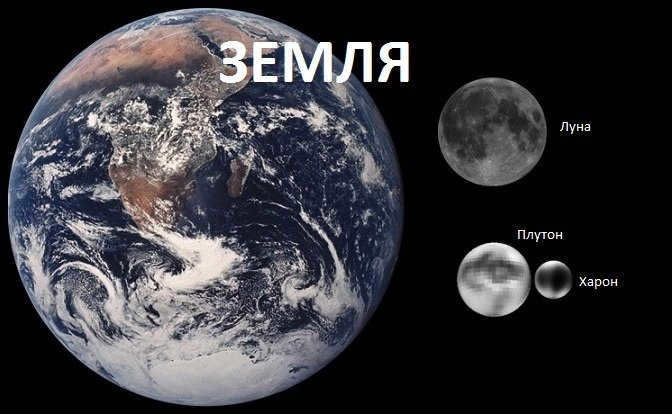
When it comes to dimensions, the former planet is extremely tiny. Pluto’s size amounts to only 18% of Earth’s, measuring 2360 km compared to Earth’s 12742 km. Nonetheless, despite its small stature, Pluto was classified as a planet. This situation appeared somewhat peculiar, especially considering the fact that there exist numerous natural satellites in the solar system that are much larger in size. Just to name a few, the colossal satellites of Jupiter and Saturn, Ganymede and Titan, surpass even Mercury in size. In terms of physical parameters, Pluto falls short even compared to our Moon, which boasts a diameter of 3,474 kilometers. Thus, it becomes evident that the size of a celestial body does not always constitute the primary criterion for determining its status in the field of astrophysics.
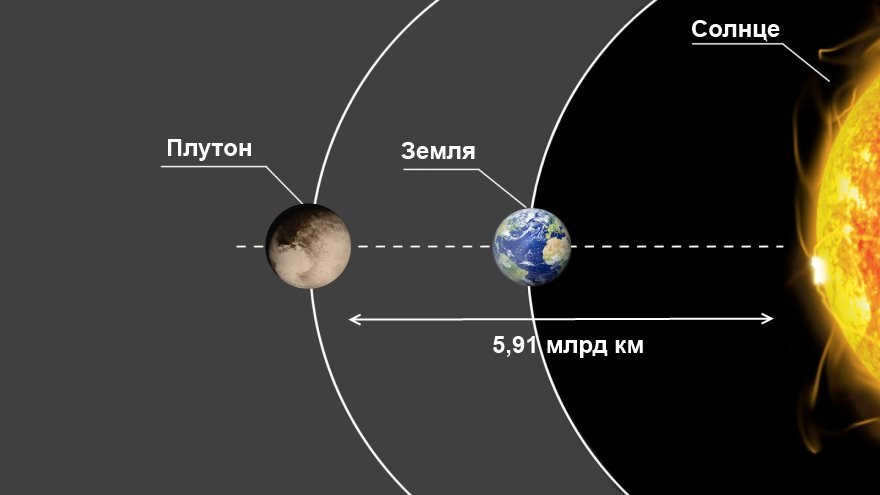
The individual who made the groundbreaking discovery of the planet lacked the necessary technological means to delve further into the vast expanse of space and arrange all the pieces of the puzzle. During that era, astrophysicists possessed only limited knowledge and information regarding the outermost frontiers of our solar system. They were unaware of the precise demarcation between the vicinity of space and the limitless expanse of outer space.
Why is Pluto not considered a planet?
Despite its small size, Pluto used to be the furthest major celestial body from the sun, located beyond the orbit of Neptune. However, advancements in optical telescopes during the second half of the 20th century revolutionized our understanding of the cosmos. Scientists were able to detect Pluto’s natural satellites and this discovery, along with other factors, led to the reevaluation of Pluto’s status as the ninth planet.
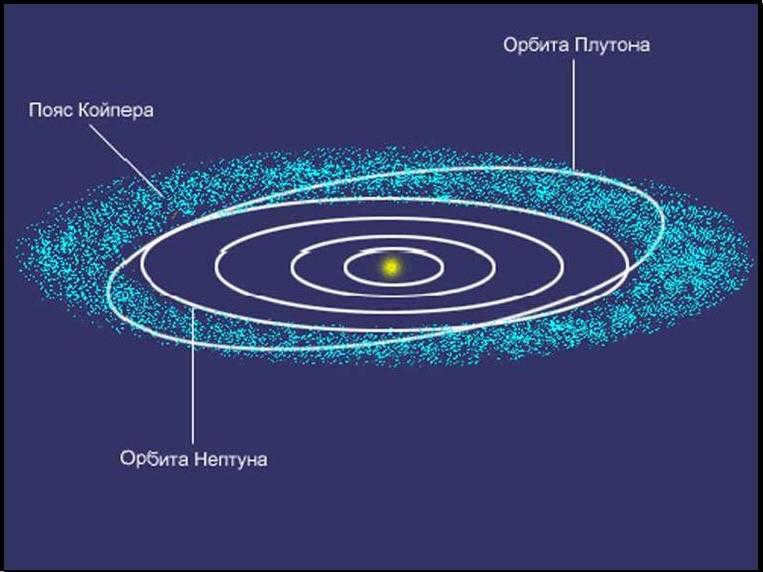
The year 2005 marked a significant milestone in the field of astrophysics. The remarkable discovery of numerous celestial objects situated beyond the orbital path of Neptune provided compelling evidence that Pluto may not be the sole dominant entity in this region of the solar system. It is now believed that there could potentially exist objects of comparable or even greater size than the ninth planet. The acquisition of precise data concerning Erida definitively settled the long-standing debate regarding the fate of Pluto. It was revealed that Erida not only surpasses Pluto in terms of its physical dimensions (measuring 2600 km as opposed to 2360 km), but it also possesses a staggering 25% greater mass.
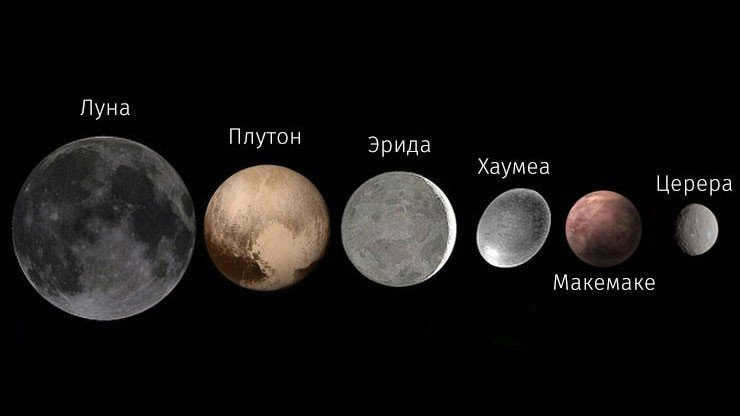
The availability of such information resulted in the scientific community having to urgently seek a solution to the situation. International conferences among scientists and astrologers became battlegrounds for this issue. After the initial presentations by scientists and astrologers, it became evident that Pluto cannot be classified as a planet. They gathered substantial evidence supporting the presence of other objects with similar astrophysical parameters and characteristics in the Kuiper belt. Advocates for revising the classical structure of the Solar System proposed that all trans-Neptunian objects be categorized as a distinct class of celestial bodies within the Solar System. Under this concept, Pluto became an ordinary transneptunian object, ultimately losing its status as the ninth planet in our stellar system.
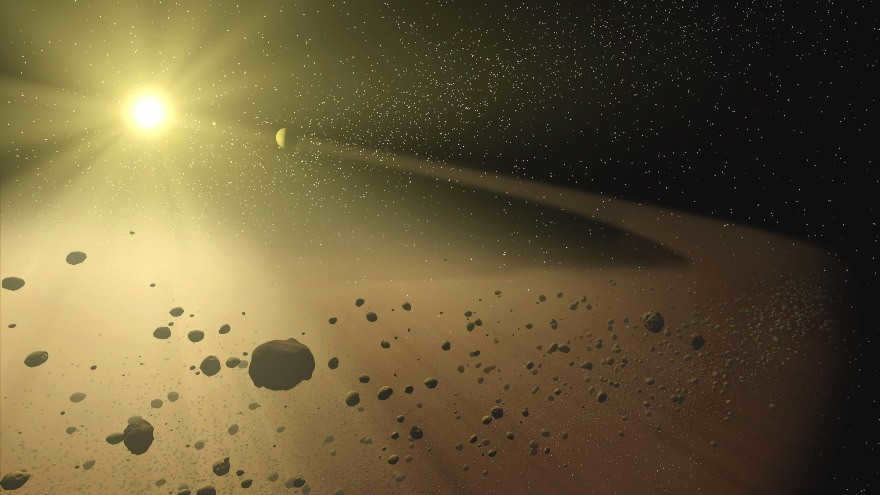
The International Astronomical Union, gathered in Prague for the XXVI General Assembly, made a definitive decision on this matter. According to the General Assembly’s resolution, Pluto has been stripped of its planetary status. Furthermore, a new definition has been established for astronomy, which includes dwarf planets as celestial bodies that meet specific criteria. Pluto, Eridu, Makemake, Haumeu, and the largest asteroid, Ceres, have all been classified as dwarf planets.
Unlike other large celestial bodies, Pluto does not meet one of the four criteria for classifying a celestial body as a planet. The former ninth planet is distinguished by the following characteristics:
- It possesses a significant mass;
- Pluto does not orbit any other celestial body and is accompanied by four natural satellites;
- The celestial object has its own orbital path, along which Pluto orbits around the Sun.
The fourth criterion, which would classify Pluto as a planet, is not met in this case. The celestial object has not been able to clear its orbit of other objects. This was the primary reason for reclassifying Pluto as a dwarf planet, a celestial body with a different status.

Supporting this idea is the notion of planet formation, where a planet becomes the dominant entity in its orbit, exerting its gravitational pull on all other bodies. As a result, a large celestial body must either assimilate smaller objects or expel them from its gravitational influence. However, based on the size and mass of Pluto, it seems that none of these events occurred for the former planet. This small celestial body has a mass that is only 0.07 times that of all other space objects in the Kuiper belt.
Essential information regarding Pluto
In the past, when Pluto was an esteemed member of the planets’ assembly, it was classified as part of the Earth group of planets. Unlike the colossal gas giants Jupiter, Saturn, Uranus, and Neptune, this former ninth planet possesses a solid surface. The opportunity to observe the surface of the most remote object in the solar system up close only arose in 2020, when the “New Horizons” spacecraft flew within a distance of 12,000 kilometers from the enigmatic deity. Thanks to this automated probe, humankind was able to witness, for the first time, a comprehensive depiction of the dwarf planet’s surface and subsequently provide a concise depiction of this celestial entity.
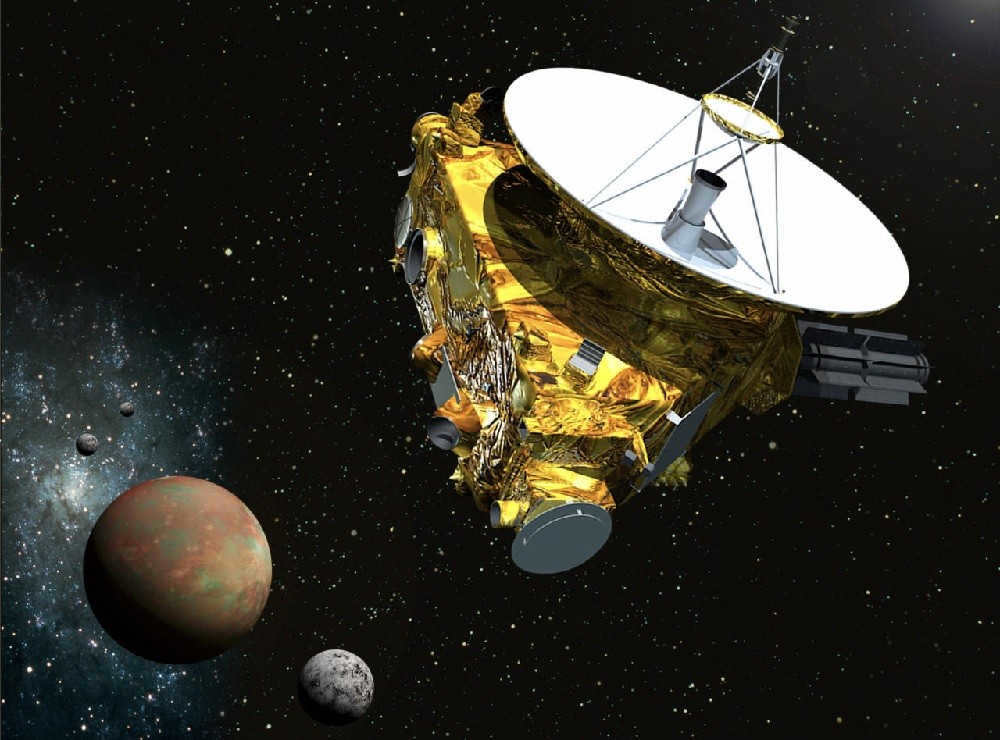
Pluto, a small celestial body that appears as a faint star in the sky, completes a full orbit around the Sun in 249 Earth years. When it is closest to the Sun, a point known as perihelion, Pluto is approximately 29-30 astronomical units away. At its farthest distance from the Sun, known as aphelion, Pluto is about 50-55 astronomical units away. Despite these immense distances, Pluto stands out from its neighboring planets Neptune and Uranus as it is composed mainly of ice, making it an intriguing subject for scientific exploration. This little celestial object rotates on its own axis once every 6 days and 9 hours, although its orbital velocity is relatively low at 4.6 kilometers per second. By comparison, the orbital velocity of Mercury, the innermost planet in our solar system, is 48 kilometers per second.
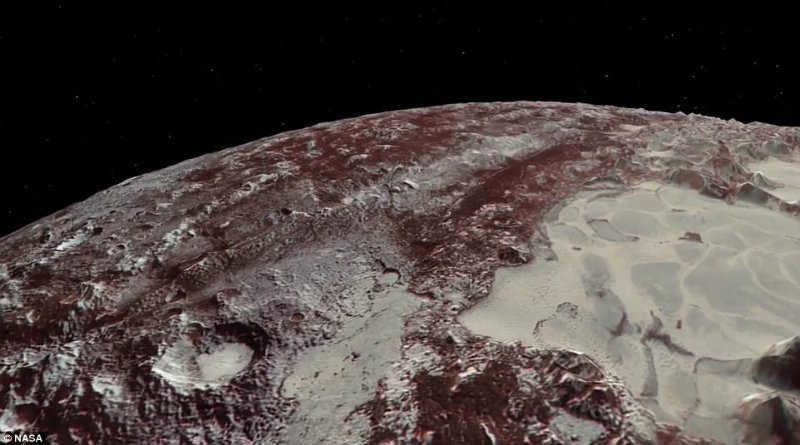
Pluto has a surface area of 17.7 million square kilometers. The majority of its planetary disk is visible and is covered in an eternal layer of ice and extreme cold. It is believed that Pluto is made up of frozen water ice, nitrogen, and silicate rocks. Essentially, it is a massive ice block with a density of 1.860 ± 0.013 g/cm3. The average temperatures on the planet are incredibly low, reaching -223 degrees Celsius. Due to its weak gravitational field and low density, Pluto experiences a minimal free-fall acceleration of 0.617 m/s2.
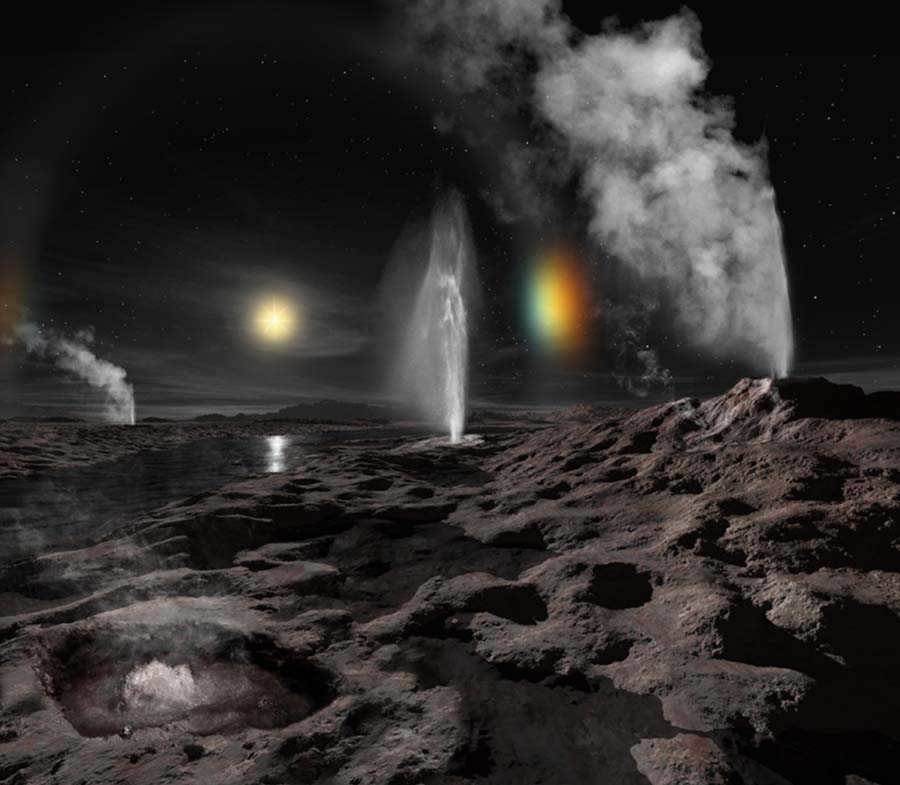
Based on the images, it can be observed that Pluto possesses depressions and mountains, with a potential altitude of 3-3.5 km. In addition to its solid exterior, Pluto also maintains its own unique atmosphere. Due to its relatively weak gravitational pull, the planet is unable to sustain a vast gaseous envelope. The gas layer measures a mere 60 km in thickness, mainly consisting of gases released from Pluto’s icy surface through intense ultraviolet radiation.
New findings in the life of Pluto
Alongside the wealth of existing data on Pluto, there has been a recent revelation of an atmosphere on Charon, the satellite of Pluto. Charon, though slightly smaller in size compared to the main planet, has sparked intriguing theories among scientists.
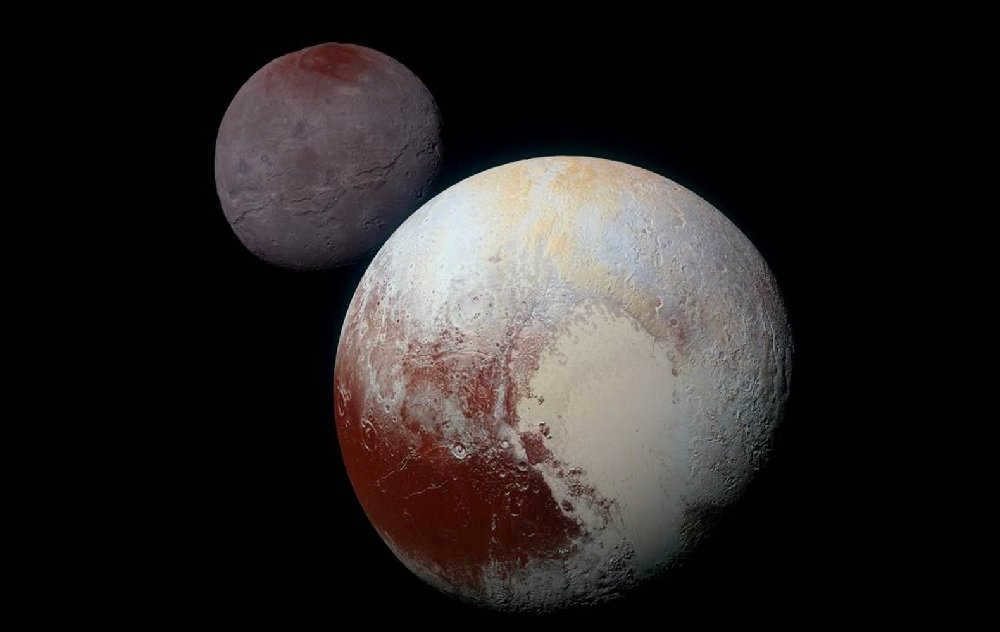
An intriguing fact is that there is a theory suggesting that Pluto and Charon are a typical binary planet. This phenomenon is unique in our solar system, as it is the only instance where the primary celestial body and its satellite share many similarities. Only time will tell if this theory holds true, while humanity continues to discover fascinating information about the Kuiper Belt, which is home to a multitude of intriguing celestial objects alongside Pluto.
Unidentified “Planet X” in the Scientific Community
In the late 19th century, astronomers postulated the existence of an additional planet within our solar system. These suppositions were rooted in scientific evidence. Specifically, while observing Uranus, scientists noted a significant perturbation in its orbit caused by unknown celestial bodies. Consequently, the discovery of Neptune followed shortly thereafter, though the perturbation remained unresolved, sparking the search for another planet. Dubbed “Planet X,” this elusive celestial body remained the focus of exploration until 1930, when Pluto was finally identified.
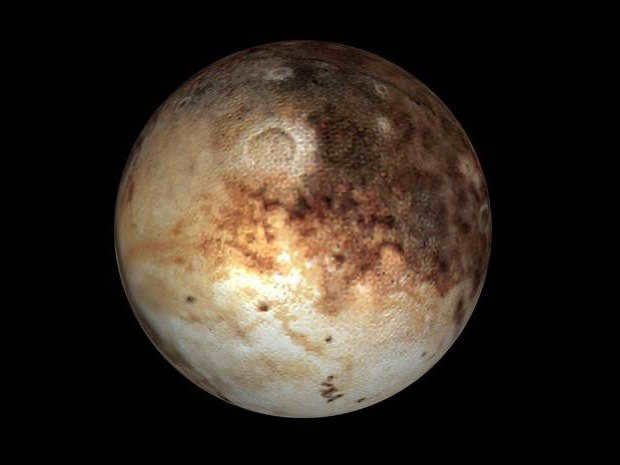

The movement of Pluto was detected on photographic plates captured over a span of two weeks. It took over a year for observations and confirmation of the existence of an object situated outside the known boundaries of the galaxy of another planet. The young astronomer Clyde Tombaugh, who initiated the research at Lowell Observatory, announced the discovery to the world in March 1930. As a result, a ninth planet emerged in our solar system and remained a part of it for 76 years. So, why was Pluto eventually excluded from the solar system? What was the issue with this enigmatic planet?
Exciting new discoveries
Once considered the final object in our solar system and classified as a planet, Pluto has undergone significant changes in our understanding. Previously, it was believed to have a mass equal to that of Earth, but advancements in astronomy have revealed that its mass is now less than 0.24% of Earth’s mass. Additionally, its diameter measures less than 2400 km. These new measurements played a role in reclassifying Pluto as a dwarf planet rather than a full-fledged planet.
Pluto also possesses various distinctive features that set it apart from other planets in our solar system. Its orbit, small satellites, and atmosphere are all unique characteristics that make it stand out.
A unique trajectory
While the orbits of the eight planets in our solar system are typically circular and only slightly inclined along the ecliptic, Pluto’s orbit stands out with its highly elongated ellipse and a significant inclination of over 17 degrees. If we were to visualize a model of the solar system, the eight planets would revolve harmoniously around the Sun, while Pluto, due to its distinctive angle of inclination, would intersect Neptune’s orbit.
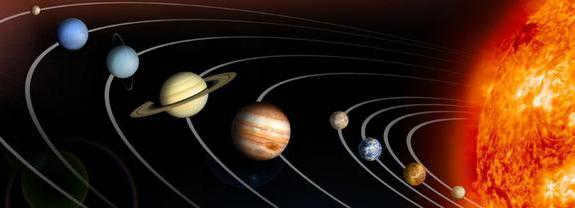
Due to its unique orbit, Pluto completes a revolution around the Sun in 248 Earth years. Additionally, the planet experiences extremely cold temperatures, with the mercury never rising above minus 240 degrees. It is worth noting that Pluto’s orbit is in the opposite direction compared to Earth, as well as Venus and Uranus. This distinct orbital characteristic was one of the contributing factors in the reclassification of Pluto, resulting in its removal from the official list of planets.
Currently, there are a total of five identified satellites orbiting around Pluto: Charon, Nycta, Hydra, Kerber, and Styx. With the exception of Charon, these satellites are relatively small in size and have orbits that are in close proximity to the planet itself. This is just one of the distinguishing characteristics that sets them apart from the officially recognized planets.
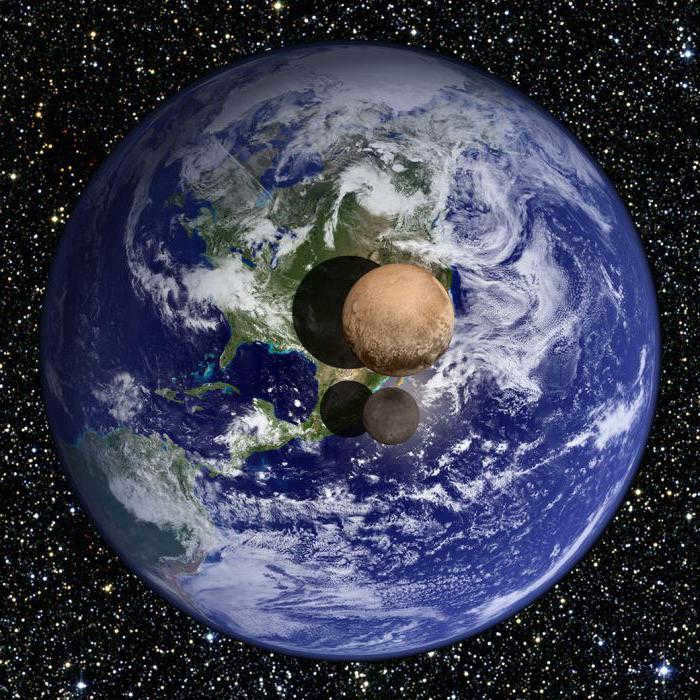
Furthermore, Charon, which was discovered in 1978, is only half the size of Pluto itself. However, it is too large to be considered a satellite. Interestingly, its center of gravity is located outside of Pluto, causing it to appear to rock back and forth. Due to these factors, some scientists argue that Charon should be classified as a double planet. This provides an explanation as to why Pluto was removed from the list of planets.
Atmosphere
Studying an object that is located at a distance that is almost impossible to reach can be a very challenging task. Scientists believe that Pluto is primarily composed of a combination of rock and ice. The discovery of its atmosphere took place in 1985 and it is primarily made up of nitrogen, methane, and carbon monoxide. The presence of the atmosphere was determined by observing the planet as it passed in front of a star. When objects without atmospheres pass in front of stars, they cause an abrupt blockage, whereas objects with atmospheres cause a more gradual coverage.
Due to its extremely low temperature and elliptical orbit, the melting of ice on Pluto creates an antiparnic effect, which results in an even greater decrease in temperature on the planet. A study conducted in 2015 led scientists to conclude that the atmospheric pressure on Pluto is influenced by its proximity to the sun.
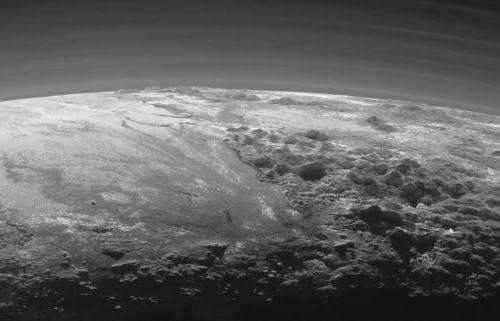

The most recent technology
The development of new advanced telescopes led to further discoveries beyond the recognized planets. Consequently, additional space entities located within Pluto’s orbit were identified. In the mid-20th century, this cluster was named the Kuiper belt. Presently, numerous objects with a minimum diameter of 100 kilometers and a similar composition to Pluto have been identified. The existence of the belt was the primary factor that led to Pluto’s removal from the list of planets.
The development of the Hubble Space Telescope enabled scientists to conduct more detailed studies of outer space, particularly distant galactic entities. This led to the identification of Erida, an object located even farther than Pluto, and eventually the discovery of two other celestial bodies with similar sizes and masses.
The AMS New Horizons spacecraft, launched in 2006 to explore Pluto, provided further confirmation of these scientific findings. This raised a question among scientists regarding the classification of these newly discovered objects. Should they be designated as planets, potentially increasing the number in our solar system from 9 to 12? Alternatively, removing Pluto from the list of planets could resolve this matter.
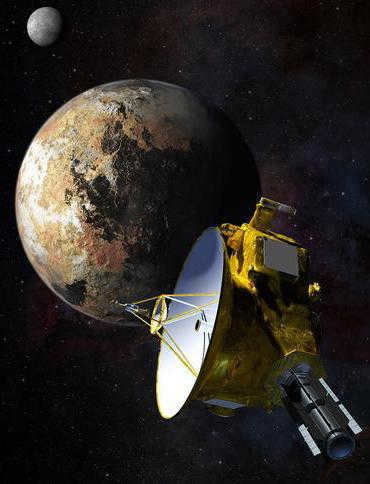
Status update
When was Pluto taken off the planet list? In a groundbreaking decision on August 25, 2006, the International Astronomical Union Congress, made up of 2.5 thousand participants, decided to remove Pluto from the list of planets in the Solar System. This decision caused a ripple effect, requiring the revision and rewriting of numerous textbooks, star charts, and scientific papers in the field.
Why was this decision reached? Scientists had to reevaluate the criteria used to classify planets. After extensive debates, it was concluded that a planet must meet all the specified parameters.
First and foremost, the object must orbit around the Sun in its own distinct path. Pluto satisfies this criterion, despite its highly elongated orbit.
Next, it should not orbit around another planet. This requirement is also met by Pluto. Initially, there was a belief that it orbited around Neptune, but this notion was abandoned when new findings emerged, including the discovery of its own moons.
The third criteria is to have sufficient mass to form a spherical shape. Despite its relatively small mass, Pluto is indeed spherical, and this fact has been verified through photographic evidence.


Lastly, the fourth criterion is having a sufficient gravitational force to clear its orbit of other celestial bodies. Pluto does not meet this requirement as it resides in the Kuiper belt and is not the largest object within it. It lacks the necessary mass to create a clear path in its orbit.
I comprehend the rationale behind Pluto’s exclusion from the roster of planets. However, where do we categorize such entities? This is where the concept of “dwarf planets” comes into play. This category encompasses all objects that do not meet the criteria outlined in the previous paragraph. Thus, Pluto remains a planet, albeit a dwarf planet.
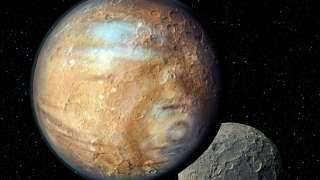

Recently, Pluto was included in the roster of planets in the solar system, holding the esteemed ninth position. This status lasted from 1930 until 2006. Changes were made to the classification of celestial bodies, resulting in one of the system’s members losing its prestigious planet title. Today, this distant celestial object orbits the Sun in an elliptical path and is recognized as a dwarf planet. It is commonly referred to by Earthlings as Pluto.
Discovery History
Following the identification of Uranus, astronomers presumed that the solar system’s planets had been fully catalogued. However, further examinations of Uranus and Neptune prompted speculation that an unidentified celestial body was exerting gravitational influence on Uranus’ orbit. This hypothetical planet was dubbed “X-Planet” and a fervent search for it was initiated. Percival Lowell diligently observed this area of the sky and even financed an observatory to aid in the search. He collaborated with Pickering to calculate potential coordinates for “object X”. In 1906, active observations commenced.

The Tale of the Title
Submissions for the designation of the fresh planet started pouring in from all corners of the globe. The responsibility of selecting the name was bestowed upon the Lowell Observatory. Historically, the planets in the solar system were named after mythological heroes. As a result, suggestions to christen the novel celestial body after the observatory’s founder (Percival) or his spouse (Constance) were not endorsed. “Zeus” and “Kronos” were dismissed – the proponents of the proposal held a tarnished reputation within the scientific community. The name “Minerva” was disregarded since an asteroid had already claimed it.
The name “Pluto” was first suggested by a young girl named Venetia Burney, who heard about the newly discovered planet from her grandfather, who worked at Oxford University. Venetia, being interested in mythology, immediately thought of the god of the underworld, Pluto, as a fitting name for the distant and cold planet. Her grandfather passed her suggestion on to his colleague Turner, who then contacted the Lowell Observatory.
Venetia’s suggestion was unanimously accepted in May 1930.
Astronomers decided to designate Pluto with a monogram in honor of Percival Lowell, while astrologers settled on a symbol resembling the sign of Neptune, but with a circle replacing the middle prong. This resulting symbol is also known as the “Phoenix”.
In the countries of Asia, a new addition to the solar system is known as the “Underground King’s Star” (or “Pit Star”).
Uncertainties
Pluto did not exhibit a visible planetary disk and was also quite faint. These factors led astronomers to question whether it was a hypothetical “Planet X.” The planet’s mass was continually adjusted downward. In 1978, the discovery of Pluto’s largest moon, Charon, allowed for the measurement of the planet’s mass, which was found to be very small, only 0.2% of Earth’s mass. Such a minuscule mass could not significantly impact Uranus’ orbit or cause any inconsistencies.
However, the quest for X-Planet persisted. The 1989 mission of the spacecraft “Voyager-2” to Neptune revealed that its mass is slightly lower than previously estimated. By reevaluating the gravitational influence of Neptune on Uranus’s orbit, scientists were able to resolve all discrepancies. Consequently, the theory proposing the existence of an alternative X-Planet was also debunked.
During the 1950s, scientists from the Soviet Union put forth the hypothesis that Pluto was not a full-fledged planet, but rather one of several celestial bodies known as dwarf planets, orbiting in close proximity to the solar system. As the new century began, this hypothesis was confirmed when a plethora of objects were discovered, many of which were significantly larger than Pluto. Then, in 2006, the international scientific community in the field of astronomy established specific criteria for classifying celestial bodies as planets. As a result of this reclassification, Pluto’s status was downgraded, and it was officially designated as a dwarf planet, with the catalog number 134340.
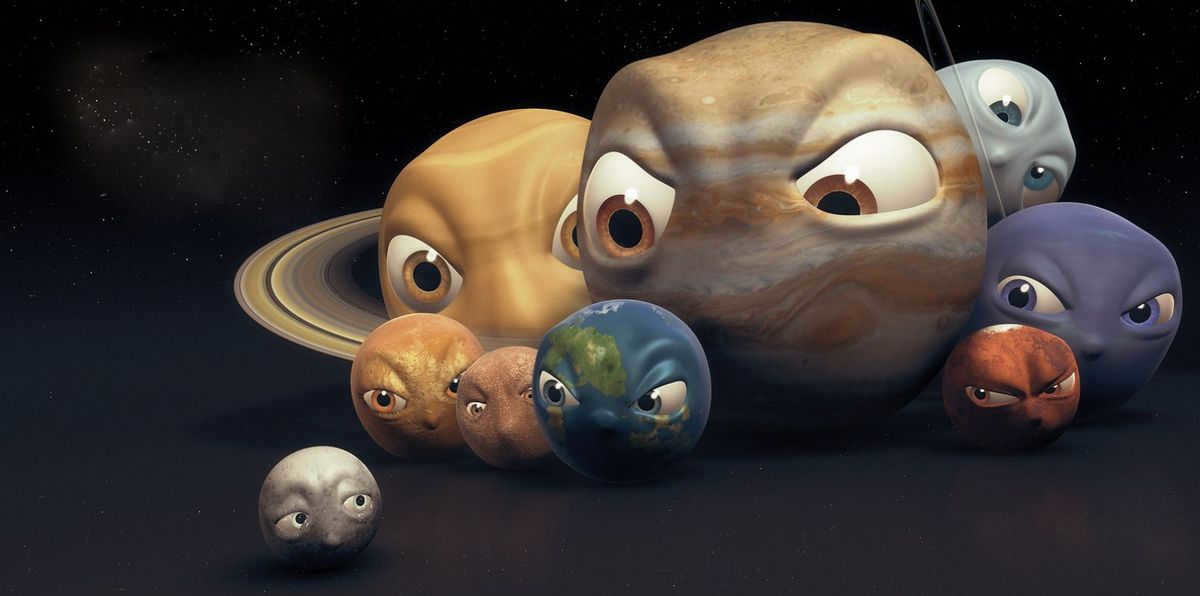
Rotation and Orbit
Exploration of Pluto is a challenging task due to its vast distance. Prior to the New Horizons flyby in 2015, much of Pluto’s nature remained a mystery. However, observations from Earth have provided some valuable insights:
- Pluto’s orbit around the Sun is unique, as it moves in the opposite direction compared to other planets, keeping Venus and Uranus as its companions;
- The planet has a significant eccentricity, resulting in its approach to the Sun even closer than Uranus, followed by a retreat of over seven billion kilometers;
- Pluto’s axis of rotation is tilted at an angle of 120°, leading to more pronounced seasons than those experienced on Earth;
- A year on Pluto lasts 247.9 Earth years, making it the slowest orbiting planet with a speed of approximately 4.7km/sec;
- Pluto rotates slowly on its axis, with a day lasting 132 Earth hours;
- The acceleration of free fall on Pluto is only 0.617 m/sec2;
- Pluto’s motion is highly unpredictable, as it can only be “calculated” for a few million years in either direction. This unpredictability is due to the chaotic nature of its motion, which can only be described using non-linear equations.
Structure
Pluto is composed of a combination of rocky material and ice. Despite its small size, it is actually three times smaller than the Moon. Its total surface area is slightly larger than Russia, spanning 17.7 million square kilometers. The equatorial radius of Pluto measures 1153 kilometers.
The interior of the planet is believed to consist of rock (up to 70%) and ice. The ice primarily consists of water and has a thickness of approximately 300 kilometers. This icy layer is separated from the rocky core, and there is a possibility that an ocean of liquid water exists between them. The freezing of water has resulted in the formation of various surface features, including grabens and scarps.
Pluto’s surface is composed of various types of ice, including volatile ice such as nitrogen, methane, carbon monoxide, and other compounds. Additionally, the presence of complex hydrocarbons and tholins gives the planet its distinctive brownish color.
The New Horizons spacecraft has provided further insights into the surface of Pluto. One notable feature is a large bright area in the equatorial zone, with a heart-shaped outline. This area is characterized by light-colored mountains that can reach heights of up to 3.5 km, contrasting with a smooth plain. Another notable feature is the “Sputnik Plain,” a massive depression that covers 5% of the surface and is filled with nitrogen ice. The plain is marked by deep cracks and furrows, dividing it into distinct cells. Within the plain, there are also “icebergs” composed of water ice. Surrounding the Sputnik Plain are mountains with ridges reaching heights of up to 5 km, also made of water ice.
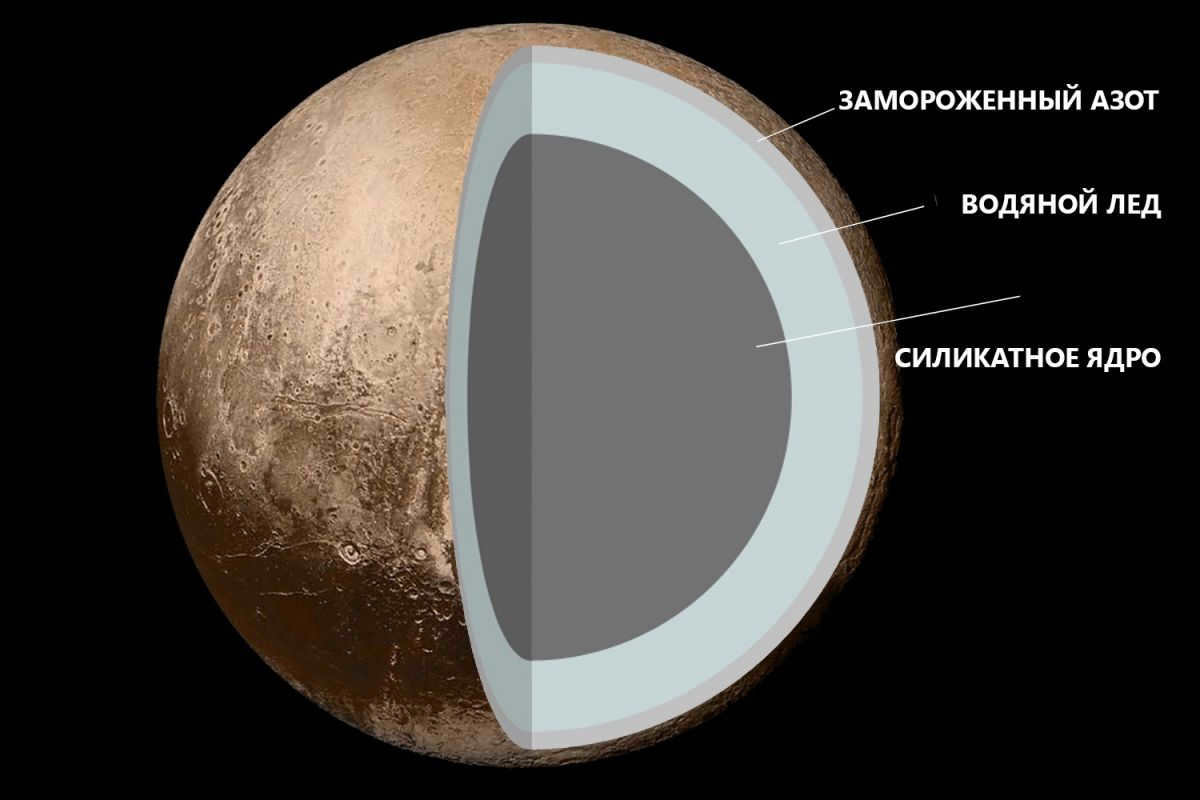

Composition of the Atmosphere and Climate
The composition of Pluto’s atmosphere was only discovered in 1985. It is extremely thin and consists mainly of evaporated gases from the surface. The primary gases present are nitrogen (90%) and methane (4%), with traces of carbon monoxide (up to 5%). The atmosphere extends to a height of approximately 200km.
As Pluto moves further away from the Sun, the atmospheric pressure decreases and some of the gases freeze and settle on the planet’s surface. This phase is characterized by complete stillness. However, as Pluto approaches the Sun, the dwarf planet is warmed, gas fills the atmosphere, and the pressure increases once again, resulting in the formation of strong winds.
However, even with the minimum pressure, the atmosphere of Pluto is capable of evening out the fluctuations in temperature that occur throughout the day. This is due to the presence of methane, which creates a greenhouse effect. It is worth noting that the temperature at the surface, which is around -223.15˚C, is actually lower than the average temperature in the atmosphere by approximately forty degrees. This means that the mountains on Pluto experience higher temperatures than the plains or depressions. Interestingly, the warmest areas on the planet are located at the poles, while the rest of the space is covered in permafrost.
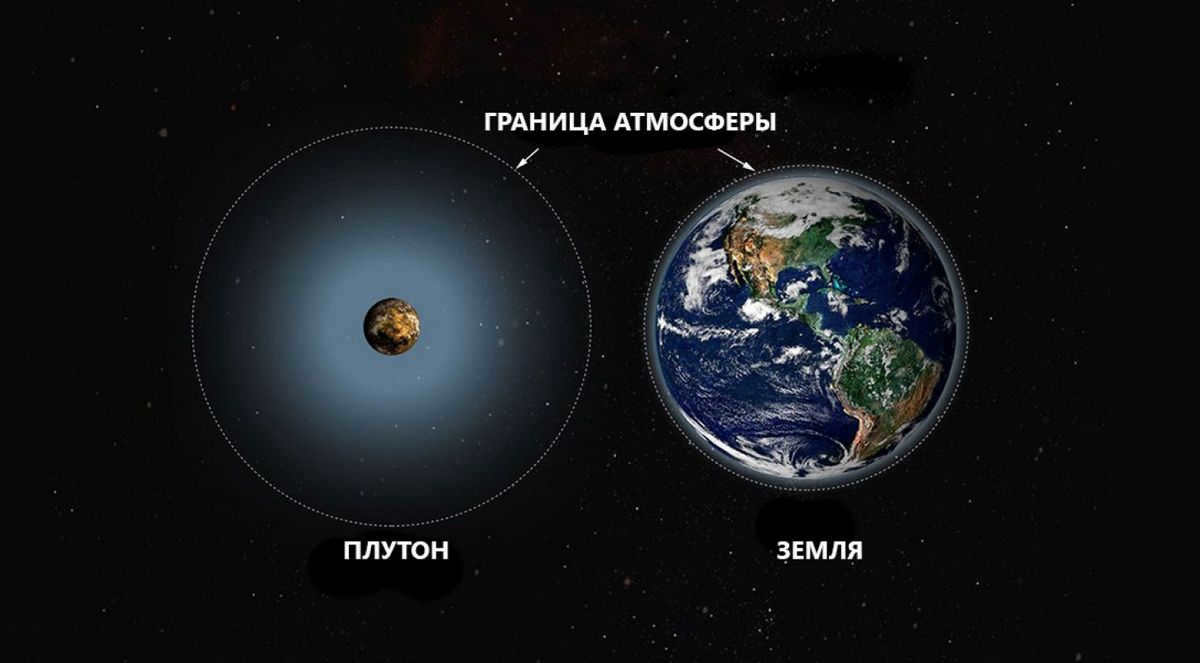

Moons
Currently, there are a total of five known moons orbiting Pluto. The largest one is called Charon. It is nearly the same size as Pluto and has a spherical shape, the main difference being its gray color. It is currently believed that Charon and Pluto are a binary dwarf planet system, although an official definition for this concept has not been established yet.
Charon always faces the same side towards Pluto and seems to be “floating” above a fixed point – in reality, its orbital period around Pluto is equal to the length of a Plutonian day.
During the period from 2005 to 2011, an additional four smaller satellites were detected: Nycta, Hydra, Kerber, and Styx. All of these satellites revolve around Pluto in a circular orbit, following the same direction as the planet. They are positioned within Pluto’s equatorial region and have an irregular shape with a distinct brightness, potentially resulting from the presence of water ice.
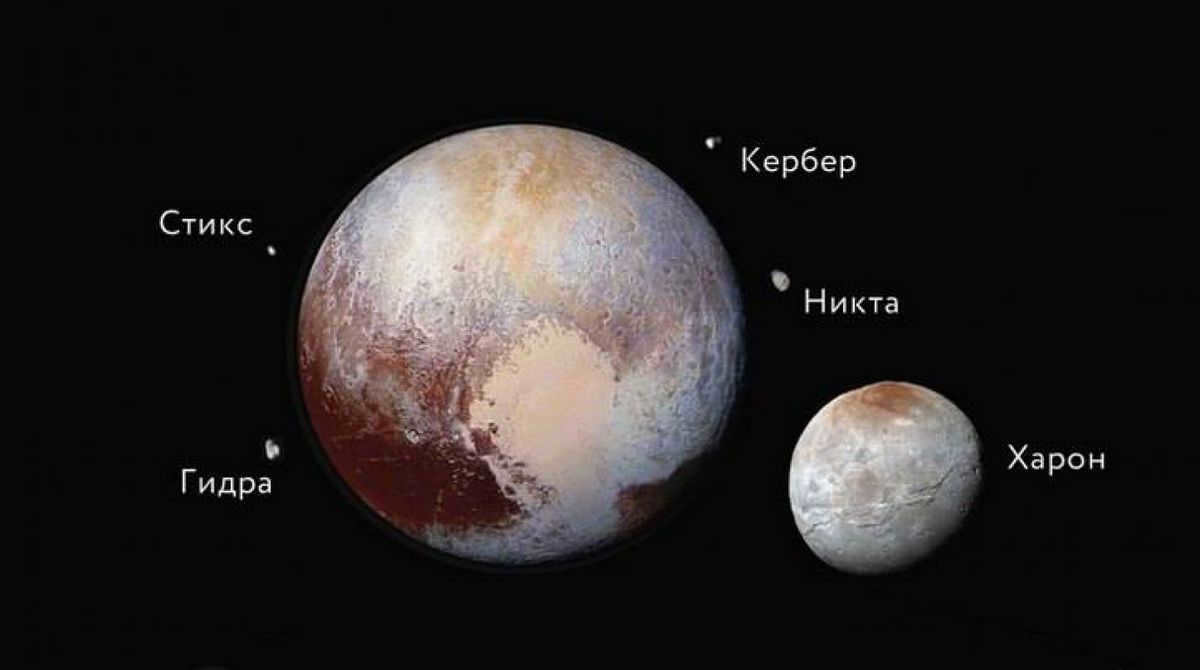
Investigation
Ever since the unearthing of the diminutive planet up until 2015, examinations of it were conducted solely through the use of potent telescopes, including those aboard the orbiting Hubble. “Voyager 1 and Voyager 2 refrained from capturing images of this particular realm of the solar system. The initial mission focused its efforts in close proximity to Saturn and its moon Titan, while the latter mission was situated too distant from Pluto. No further endeavors were made until the 1990s. It was during this time that the matter of investigating Pluto and the Kuiper Belt was once again brought to the forefront. In 2006, the New Horizons mission was initiated, with a capsule containing the remains of one of Pluto’s discoverers, Clyde Tombaugh, onboard.”
In July 2015, the planet was approached by a spacecraft equipped with spectrometers and newly developed instruments capable of penetrating the densest atmosphere with radio waves. The data collected by these instruments enabled scientists to create maps of Pluto and Charon, examine their geology and morphology, and analyze the atmosphere of the planet.
The transmission of data on small satellites by New Horizons raised concerns for the mission. The potential danger was that satellites could be bombarded by meteorites and the resulting particles could form rings that could potentially damage or destroy the spacecraft if it were to get caught in them. However, no rings were discovered, allowing the mission to proceed without interruption.
After flying close to the planet and its moons, the device captured images of them from various angles, excluding the regions experiencing polar night at that particular time. The data gathered by the probe during its journey to Pluto and in its proximity is currently undergoing processing and analysis in NASA laboratories.
Pluto’s Significance in Science and Literature
As early as 1943, the name of the newly discovered planet was assigned to a synthetic element on Earth. Plutonium joined the ranks of neptunium, uranium, cerium, and palladium. Despite not being depicted as a potential colonization site in novels, Pluto still made appearances in science fiction literature and movies as an unmanned station located at the outer edge of the solar system.
However, Pluto consistently makes appearances on postage stamps. Notably, it has been featured on stamps from various countries including Albania, Romania, the People’s Republic of China, and the Republic of Chad. An interesting occurrence took place in May 2016 when the North American Post Office Department released a set of four stamps showcasing the New Horizons spacecraft and its captivating pictures of Pluto.





